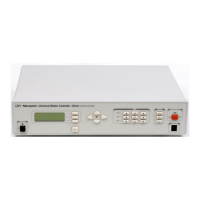Assuming that axis 1 and 2 are configured, Example 1 instructs the
ESP controller to move axis 1 to absolute position +30 units, wait for
it to stop, and then move axis 2 motor to relative –10 units.
Note that a command prefix identifies the axis or group that should
execute a command. Commands received without an axis prefix
generate an error. If a command is referenced to a non-existing axis, an
error is also generated. See Section 3.4 for further details on the
command syntax.
Also note that it is necessary to explicitly instruct the ESP controller
with the WS (Wait for Stop) command to wait for axis 1 motion to
stop. This is necessary because the ESP controller executes commands
continuously as long as there are commands in the buffer unless a
command is fetched from the buffer that instructs the controller to
wait. Executing a move does not automatically suspend command
execution until the move is complete. If the WS command were not
issued in Example 1, the controller would start the second move
immediately after the first move begins and simultaneously move axis
1 and axis 2.
NOTE
Unless instructed otherwise, the ESP controller executes
commands in the order received without waiting for completion
of previous commands.
Remember that commands must be terminated with a carriage-return
(ASCII 13 decimal). Until a terminator is received, characters are
simply kept in contiguous buffer space without evaluation.
Example 2:
1PA+30; 1WS; 2PR-10
Example #1 and Example #2 perform the same operations. In
Example #2 however, semicolons are used in place of carriage-returns
as command delimiters, keeping the ESP controller from interpreting
any commands on that line until the carriage-return terminator is
received at the very end of the string.
3-2 Section 3 – Remote Mode

